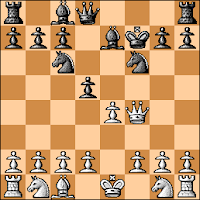
An exchange of emails with Jerome Gambit Gemeinde member Pete Banks ("blackburne"):
Not sure if I mentioned this, but one of my Internet wins with the Jerome is in Gary Lane's book The Greatest Ever Chess Tricks and Traps .
Pete
Hi Pete,
I've got dibs on the review copy of Gary's book when it shows up at Chessville, so I'll be able to see your game in print with my own eyes. Congratulations all over again!
As for the first publication of a complete Jerome Gambit game in book form, I think your game is a rare item, but not the first.
Andres Clemente Vazquez included three Jerome Gambits from his second match with William Carrington in his book Algunas Partidas de Ajedrez (1876); and he shared his game against L. Giraudy in the 2nd & 3rd editions of his Analisis del juego de ajedres: libro a propositio para que pueda aprender dicho juego, el que lo ignore del todo, in necesidad de maestro (1885, 1889). (Not in the 1st edition, mind you: it was published in 1874, the first year that the Jerome Gambit saw print.)
Of course, the infamous game Amateur - Blackburne, London 1885, appeared in Mr. Blackburne's Games at Chess (1899), and thereafter in numerous books, including Handbuch des Schachspiels - 8th ed (1916); Du Mont's 200 Miniature Games of Chess (1942); Chernev and Harkness' An Invitation to Chess A Picture Guide to the Royal Game (1945); and Wenman's Master Chess Play (1951).
More recently, Eric Schiller has included Amateur -Blackburne in his Unorthodox Chess Openings (1998, 2002) and Gambit Chess Openings (2002); and, with John Watson, his Survive and Beat Annoying Chess Openings (2003).
Hope that isn't rain on your parade -- your game appears to be the first game from this century and the past one to appear in book form, as far as I know. Good enough?
Best wishes,
Rick




 Again, RevvedUp would like to head toward the endgame. For this 14...Qe5 was also a possibility. Shredder 8 should now swap Queens.
Again, RevvedUp would like to head toward the endgame. For this 14...Qe5 was also a possibility. Shredder 8 should now swap Queens.

 Ouch!
Ouch!






















